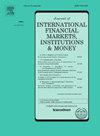利率规则中的外汇市场压力
IF 5.4
2区 经济学
Q1 BUSINESS, FINANCE
Journal of International Financial Markets Institutions & Money
Pub Date : 2024-05-18
DOI:10.1016/j.intfin.2024.102005
引用次数: 0
摘要
许多中央银行都追求某种汇率目标。我们推导出中央银行在设定利率以实现特定目标时应关注哪些变量。汇率市场压力(EMP),即汇率变动的趋势,成为关键变量。这就产生了一种利率政策规则,即在泰勒规则中加入 EMP。EMP 的系数取决于两个结构参数,即利率抵御贬值的有效性和汇率管理的程度。该规则可以实施多种制度,从浮动汇率到中间汇率再到固定汇率。它可以应用于许多模型,我们在一个小型开放经济体的新凯恩斯主义模型中对其进行了说明。本文章由计算机程序翻译,如有差异,请以英文原文为准。
Exchange market pressure in interest rate rules
Many central banks pursue some kind of exchange rate objective. We derive what variables the central bank should look at when setting the interest rate to implement a given objective. Exchange market pressure (EMP), the tendency of the exchange rate to change, emerges as the key variable. This yields a policy rule for the interest rate where EMP is added to, say, a Taylor rule. The coefficient for EMP depends on two structural parameters, namely the effectiveness of the interest rate to ward off depreciation, and the degree of exchange rate management. The rule can implement many regimes, from floating to intermediate to fixed rates. It can be applied to many models, and we illustrate it in a New Keynesian model for a small open economy.
求助全文
通过发布文献求助,成功后即可免费获取论文全文。
去求助
来源期刊
CiteScore
6.60
自引率
10.00%
发文量
142
期刊介绍:
International trade, financing and investments, and the related cash and credit transactions, have grown at an extremely rapid pace in recent years. The international monetary system has continued to evolve to accommodate the need for foreign-currency denominated transactions and in the process has provided opportunities for its ongoing observation and study. The purpose of the Journal of International Financial Markets, Institutions & Money is to publish rigorous, original articles dealing with the international aspects of financial markets, institutions and money. Theoretical/conceptual and empirical papers providing meaningful insights into the subject areas will be considered. The following topic areas, although not exhaustive, are representative of the coverage in this Journal. • International financial markets • International securities markets • Foreign exchange markets • Eurocurrency markets • International syndications • Term structures of Eurocurrency rates • Determination of exchange rates • Information, speculation and parity • Forward rates and swaps • International payment mechanisms • International commercial banking; • International investment banking • Central bank intervention • International monetary systems • Balance of payments.

 求助内容:
求助内容: 应助结果提醒方式:
应助结果提醒方式:


